Was that thunder? No, it was a vessel running aground!

When you hear the sound of thunder on a clear day, it catches your attention. That is why, while sitting in the cockpit reading on my Kindle, when I heard the loud bang, I called down to Rebecca to ask if she had heard it too. It only took me a second more to figure out that the sound I heard had not at all been generated by a lightning storm. Rather, it was caused by a boat running hard aground on the reef off our starboard side.
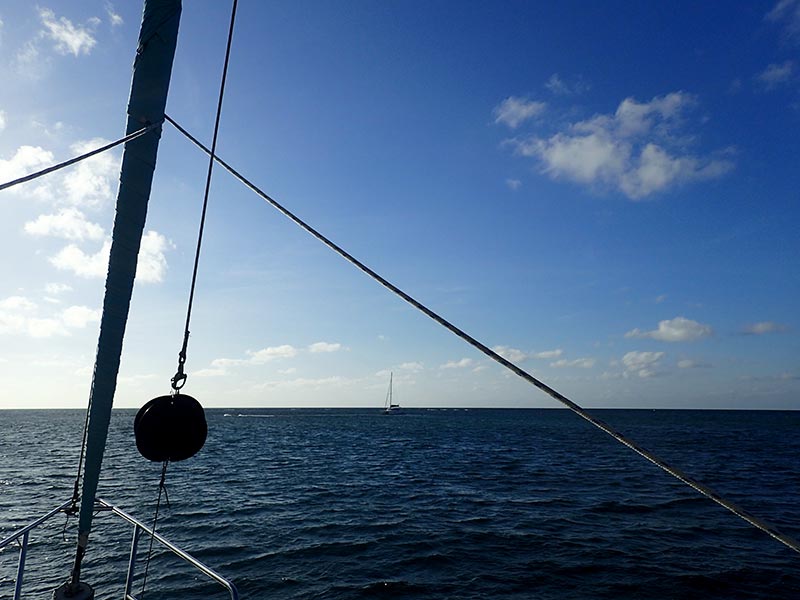
Early Tuesday morning after spending the night on the reef.
These reefs can be tricky!
The reefs bordering the southern coast of Grenada can be tricky. Many vessels have gained closer knowledge of them then they would have liked, unfortunately including one owned by friends of ours. Local knowledge helps when navigating this area, as does having good light to read the water depths. As the boat that just hit the reef was a rental boat, and it was approximately 5:00 PM when the grounding occurred, we can assume that they had neither. Of course, honoring the channel buoys* and paying attention to your chart(plotter) is also important!

More than one boat has had a run-in with these reefs!
We watched the catamaran for only a moment or two, ensuring that it was hard aground, before we jumped in our dinghy to go see them. The vacationers, who we learned were on the very first day of their charter, were obviously shaken, but OK when we arrived. I suggested that they first check the bilges to ensure that they weren’t taking on water, and once we determined that they weren’t sinking, Rebecca and I scouted around the boat in our dinghy to see if there was an easy way off the reef. There wasn’t!
The skipper, using both engines at high revs, tried to no avail to free the boat from the reef. About all he managed to do was spin the boat 90 degrees so that it was oriented north-south, and likely scrape some off the keels. Acknowledging that he was most definitely stuck, and that he’d be unable to get himself free, he did the wise thing and put in a call to the manager of the charter base, letting him know of the drama. Using our handheld VHF, I put out a radio call to Denise from Safe Yachts, hoping that she’d be able to drum up some help too.
The boat wasn’t going anywhere so Rebecca and I would have been happy to ferry some or all of the crew to shore. They assured us that they were OK though, so we left them with our boat name, and instructed them to call us if they needed further help. Surprisingly, we were the only people to come out to the boat. Normally situations like this are met with a flood of cruisers on scene, ready to help.
Once back on our boat, I searched my phone for the number of the charter base manager, Richard. While I was doing so, our friend Chris from LTD Sailing zoomed up in his dinghy, having just received a call from Richard, asking if he would find out what the story was. I briefed Chris on the status of the boat, and as we sat on Frost, he passed on the info to Richard.
By this point, we had lost all light. Richard decided that he’d drive down to the harbor, and we agreed to run him out to the boat so that he could speak to the guests. As Chris, Rebecca and I sat waiting for him to arrive, one of the work boats that service Calivigny Island, an exclusive private island here, showed up on scene, and for some time seemed to be trying to help the grounded cat. As I said though, it was completely dark, so we could only see the vessel’s nav and search lights moving back and forth in the deeper water of the channel. Before Richard could arrive, Chris and I went back out into the channel to see if we could find out what was going on. The lone worker on the boat, a vessel that many people here refer to as Tin Man, unfortunately did not speak English. With nothing much happening, shortly thereafter, I returned to Frost, soaking wet, Chris to his office, also soaking wet, and Tin Man to the dock (likely not as wet).
A bit later Tin Man returned to the scene, and we could hear from the voices as they motored passed Frost that there was now more than one person on board. Richard, Chris and another guy, Anthony, arrived shortly thereafter, and the four of us went back to the boat, now my third trip out there. When we arrived, already completely soaked from the waves, we could see that the guys on Tin Man had secured a line to the grounded cat, and were attempting to pull it off. The workboat, while powered by a couple of big outboards, is quite light, and thus was having no affect. It also appeared that one of the boat’s large outboard engines had been disabled, which I believe had been caused by the guys onboard getting a line caught on the prop while trying to set up the tow.
Not long thereafter, Tuff Lady, a second, much-heavier, Calivigny workboat, arrived on scene, and using our dinghy, we helped to pass lines from one boat to the other. They tried to use both boats in tandem to pull the cat backwards, and we wisely moved out of the way. As we feared, the line snapped, and the tow was aborted.
By this time, the catamaran was high and dry. Richard wanted to speak to the guests and inspect the boat first hand, so we made our way over to it, across the reef. The water had dropped so much by then that we grounded our prop on the reef, and had to paddle our way to the vessel, all the while trying not to get flipped by the waves that were breaking into the dinghy.
We held on to the side of the boat, chatting with some of the crew while Richard got on board and verified that the boat was not taking on water. Surprisingly, we found that Ben, the general manager of Calivigny Island, was there with them. Somehow, while setting up the tow, he managed to board the cat, and given his attire, I think that his boarding may have involved some swimming!
The guests were once again given the opportunity to depart the boat, but as they were in no immediate danger, Richard didn’t force them, and they opted to remain on board. Before we departed, a plan was made to attempt a tow again the following morning at high tide. The last thing we did before departing was to set the boat’s spare anchor as a kedge, to windward off the cat’s starboard stern quarter.
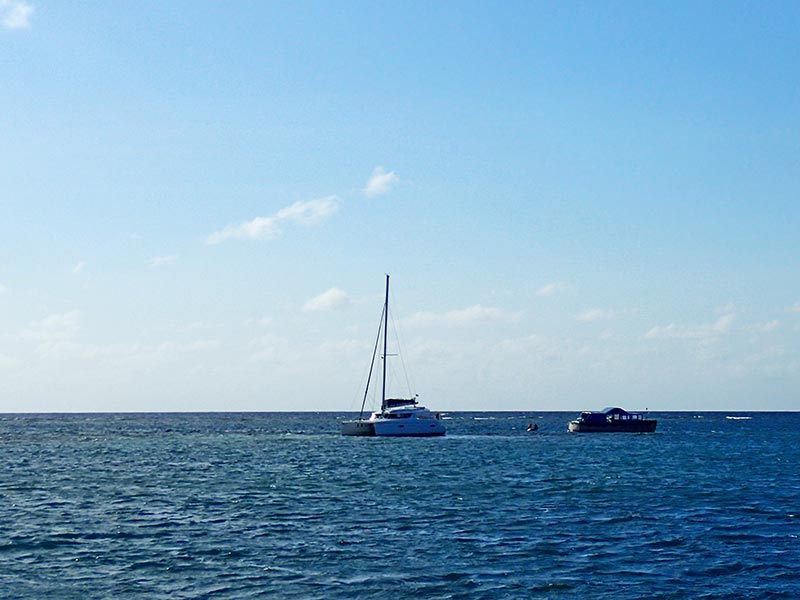
Chris and I in the dinghy with Tuff Lady working to free the grounded cat.
It’s a new day!
Just after 6:00 AM the next day, with barely a cup of coffee in my stomach, Chris and Richard arrived to our boat to pick me up. As Chris was experiencing a bit of outboard engine issues, we left his dinghy at our boat, and took our smaller tender out to the still-grounded cat. I had checked the tides on the web and came up with a time for high tide of 6:51 AM**. While we waited for Tuff Lady to return, we had the guests depart the boat in its tender, and we dumped the cat’s fresh water supply to lighten its load. We used the available dock lines to rig a bridle, and prepped lines to run out to the tow boat. Unfortunately, rescuing grounded boats is not the primary use for the Calivigny boats, and by the time that they finished the work that they needed to do before helping us, we had lost the high-tide advantage. We made several attempts to free the cat but had no success. Conceding that it wasn’t going to work, the skipper on Tuff Lady told us that he’d return with an even bigger boat. As we waited for him to return, Mother Nature conspired against us, lowering the water level even further.
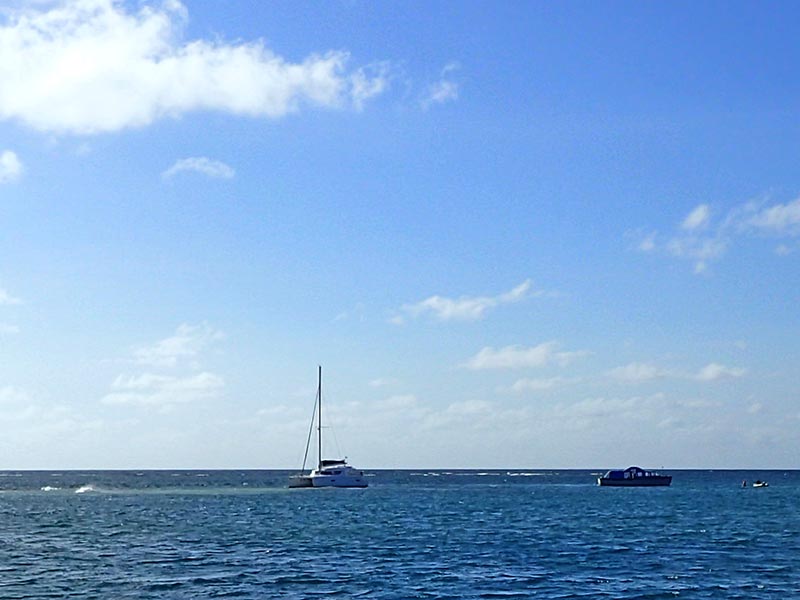
Note the shallow water under the boat. We had lost the high-tide advantage.
By the time that the bigger boat, a large, steel landing craft, had arrived, the cat was once again, near high and dry. We tried several times to tow it off, breaking a couple of cleats in the process. Chris was in the water swimming several times, retrieving lines and freeing them from coral, and with little water over the reef, we did a lot of paddling, trying to save the outboard from the coral heads. After snapping all the lines that we have available, Chris and I made a trip back to Frost to pick up some huge hawsers that we had stored in a locker. I knew they’d come in handy some day! Using these larger lines, we made one final attempt to tow the boat off the reef, but wisely bailed, realizing that, with the lack of water over the reef, we’d likely cause significant damage to the boat, and the coral, in the process. Once again we left the catamaran, with plans to meet up again at the next high tide for a third attempt.
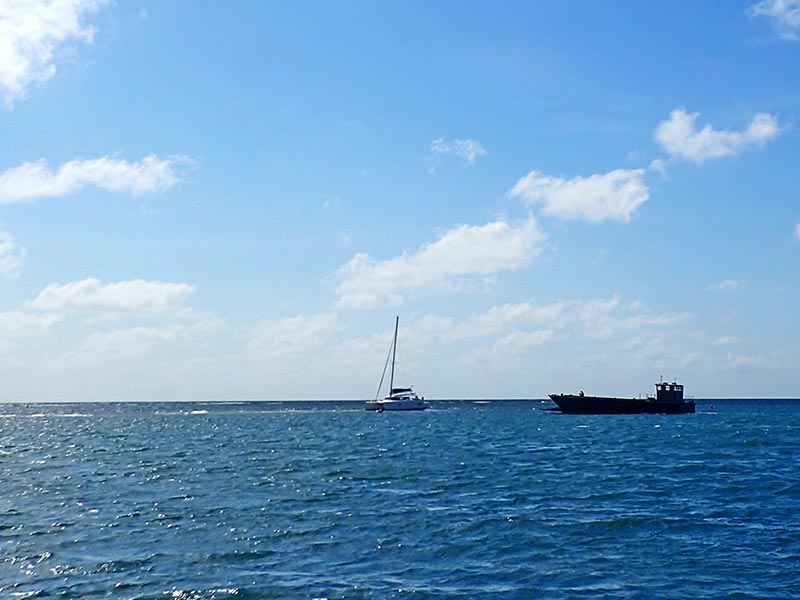
Yes, a much bigger boat!
Helping our friends find their new home
I would have loved nothing more than to take a nap at that point but instead, while Chris returned to his office to work, and Richard went off to purchase new lines for towing, Rebecca and I dinghied over to Clarks Court Bay to help Steve, Darla, and Tyler move Forever off the dock. We had scouted out a spot in the Hog Island anchorage for them, virtually the same spot where Rebecca and I spent much of our first season in Grenada anchored. Our trip around to Hog Island in their boat was largely uneventful, and we were all happy to set the anchor in such a beautiful spot.
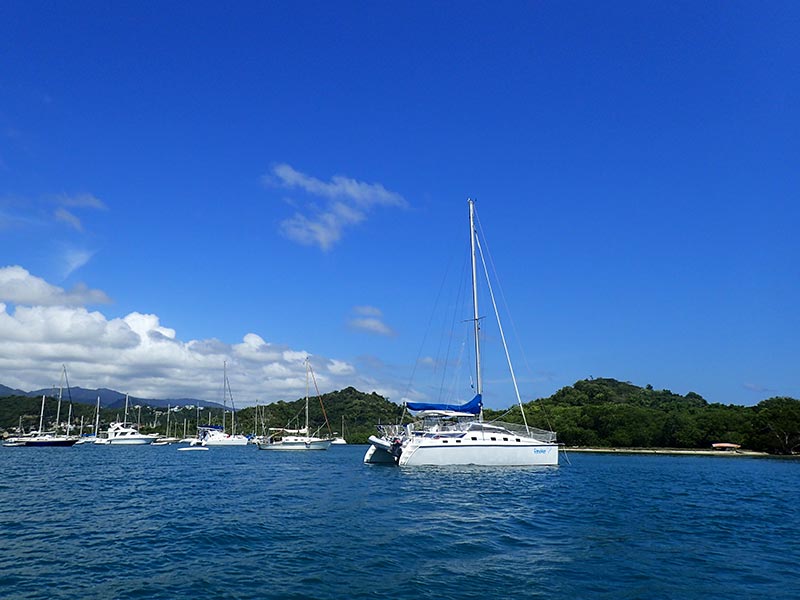
Forever anchored in one of her favorite spots!
Returning to Frost, we could see that the water had once again risen enough to set the cat bouncing. That nap that I was looking for was apparently still not going to happen! I phoned Chris and Richard to let them know what we could see, and as the landing craft made its scheduled return to the site, I dinghied to shore to pick the guys up so that we could try again.
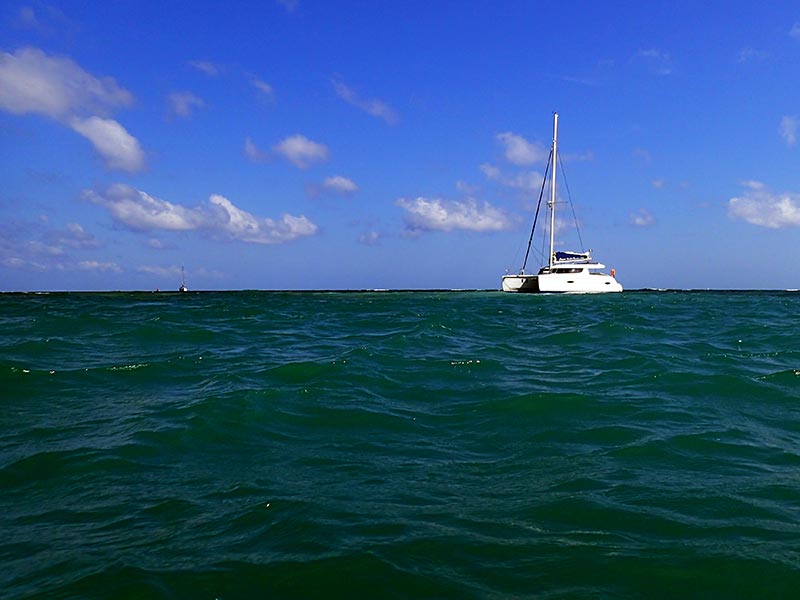
Yesterday afternoon, just before high tide.
Take 3!
Since I last saw him, Richard had purchased 200′ of large diameter line to run for the tow. We got it on board the cat and flaked it on the trampoline so that it would pay out smoothly. Oh yeah, we were all soaked once again! As Chris and I used the dinghy to run the line out to the landing craft, we were confused to see the guys on board it waving their arms at us. With the sound of our outboard working in tandem with the wind, we were unable to hear what they were saying so we kept going. It wasn’t until we were almost to the boat that we could understand what they were saying, “She’s already off the reef!” Turning to look behind us, we could see what they were telling us, the kedge anchor had apparently given way, and with the high tide, the boat had drifted off the shallow portion of the reef. Even Richard, who was on board the boat, hadn’t yet noticed! It must have just happened.
Chris and I quickly returned to the cat, gathering up the large tow line as we did. Chris jumped back on board to secure the line as Richard fired up the engines. The next question for all of us was, would the boat have steerage? While no doubt damaged, and acting up a bit, the rudders worked well enough that Richard was able to get the boat down the channel and tied up to LTD Sailing’s dock at Secret Harbor.
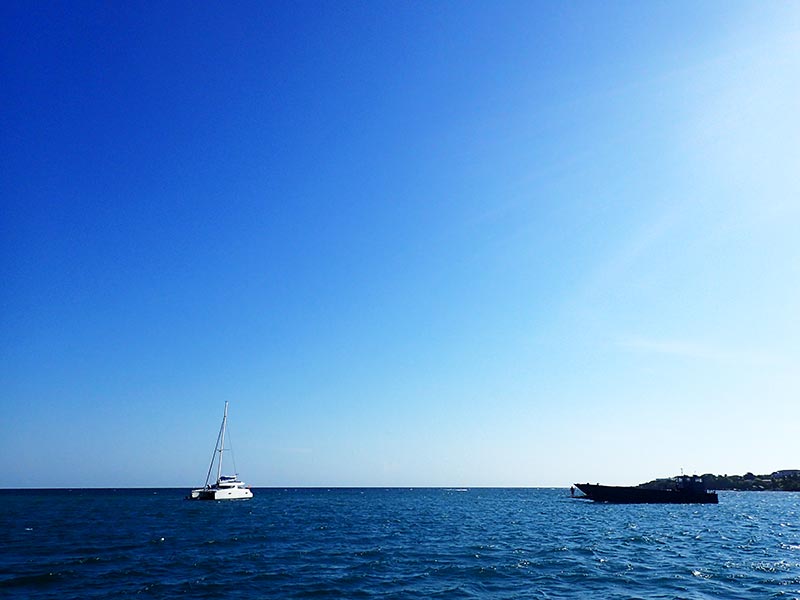
She’s free!
In the end, this unfortunate situation couldn’t have resolved itself much better. While there is certainly some keel and rudder damage, it ended up being much less than any of us would have guessed. We saw that the guests were all safe and in good spirits, as was Richard surprisingly. Even more importantly, no one was hurt in the process of trying to free the boat. The cold beers consumed following this bit of drama were, if I do say so myself, well earned by all those involved!
*Channel marks sometimes go off station. I know of at least one here that is seriously misplaced. Never rely upon only one source of info for navigation.
**This is the site I used to look up the tides. While it could be operator error, it seemed to be completely in error. The info we found on the Garmin chartplotter and Navionics app did not agree with what this site showed, nor did reality!


Is it not possible to rely on the GPS & included charts to avoid the reefs in that region?
While I have found that the electronic charts we have (Garmin and Navionics) are good in 99% of the spots that we have been to in Grenada, as I wrote in the post, a prudent mariner will never rely upon a single source of data, in any area.
Eyes
Charts (electronic and paper)
Navigation marks
Depth sounder (comparing to charts)
Note I said 99%. That means that we have been to at least one spot where the electronic charts could get you into serious trouble!
Also of interest in this situation, the Aids To Navigation in this area are private and not shown on the charts.
Yes.
Well done. And responsibly done. What an astonishing fluke that the boat floated off, not further onto the reef.
It must be a sturdy cat to have taken a hard, noisy hit on coral and not been holed.
Mike
We were all surprised!
In this particular instance the charter boat appears to be aground on a quite substantial section of reef. In that they were underway at 5 pm it would seem to preclude the possibility of being able to ascertain the presence of a reef visually. Curiously, do you know whether in this specific case the electronic charts accurately depict the location of the reef?
My question goes to the question of competency in that I’ve come to believe that the charter companies have a protocol for ‘qualifying captains’ that is woefully inadequate. I firmly believe that they allow insufficiently qualified persons to operate their vessels which tends to effectively subsidize a hazard to the charter captain & crew as well as others (i.e. – poorly anchored boats dragging down on nearby vessels).
There is also some (what I consider) excessive blow-back that is now being directed at all cruisers in the form of crazy-high fines for going aground – most likely due to incidents such as this. A recently enacted law in Belize calls for a fine of between $ 5,000 and $ 25,000 “per square meter” of reef that is damaged by a vessel going aground.
Personally, I’d like to see those who are operating a vessel in a reckless manner receive the consequences of their actions personally rather than have all sailors be painted with the same brush of incompetence. In other words, the charter companies that are not properly vetting their customers need to stop renting to unqualified persons.
Of course I recognize that none of what I said pertains to the situation at hand when another boat is in need. It’s just that seeing what appears to be another example of this problem draws me to raise this over-arching issue that I feel warrants some attention.
Back to the what you did . . . . kudos to you for that exemplary multi-day rescue effort. You’re certainly deserving of a five star ‘Good Samaritan Award’!
Hi Ross.
In answer to your first question, yes, it seems to me that the electronic charts that I have used (Garmin, Raymarine, Navionics, Garmin Bluechart Mobile) all represent these reefs properly. When using them, keeping the boat in the middle of what is represented as the deep channel should keep the boat safe.
As for the vetting of charter Captains, I can’t say what is required or expected. When deciding on the Leopard 4600 for charter purposes, we rented one from the Moorings. We simply told them that I was a Captain and that I knew the area, and that seemed fine. No documentation to prove our claims was requested. Perhaps others who have chartered can chime in.
When I read the title of this post my heart just sank. So happy it was not you. I would have been very surprised if it was given how meticulous you two are.
Thanks for the story,
Jeff
Well, anyone can run into trouble, but we do try our best to stay safe. Thanks for the concern. It is appreciated!
Great post . Interesting read. We have been getting extreme tides here in NY this past week coinciding with the moon, but my sailflow app is usually correct on the timing. Tides have increased this week from 3 foot normal swing to 5 foot.
Yes, Spring tides at the full and new moons. That’s when we can really notice it here.
When we used to charter before buying our boat the charter companies requested a copy of my sailing resume when making the booking but they never asked too many questions when we arrived. Pretty much moved aboard, did a check out of the boat with them, had some discussion of our plans & headed out when we were ready.
I’d say in the boat check out when going over things, however, they would be able to get a feeling if the skipper was capable or not . So I would hope they would ask more questions if they had any concerns.
We enjoyed great charters around Vancouver, BC, and in Mexico and the eastern Caribbean, fortunately without any problems. Other than things that broke of course! But that was all part of the learning process too. 🙂
Things break on boats, a fact of life! 🙂
Great story. Glad nobody was injured by snapping tow lines. A common occurrence. I saw a sailboat hit a sandbar in the Bahamas full tilt at twilight. The charts were very clear about the location and depths. He must have had no charts or was three sheets to the wind. He did float off on the next tide with no adventure like you had.